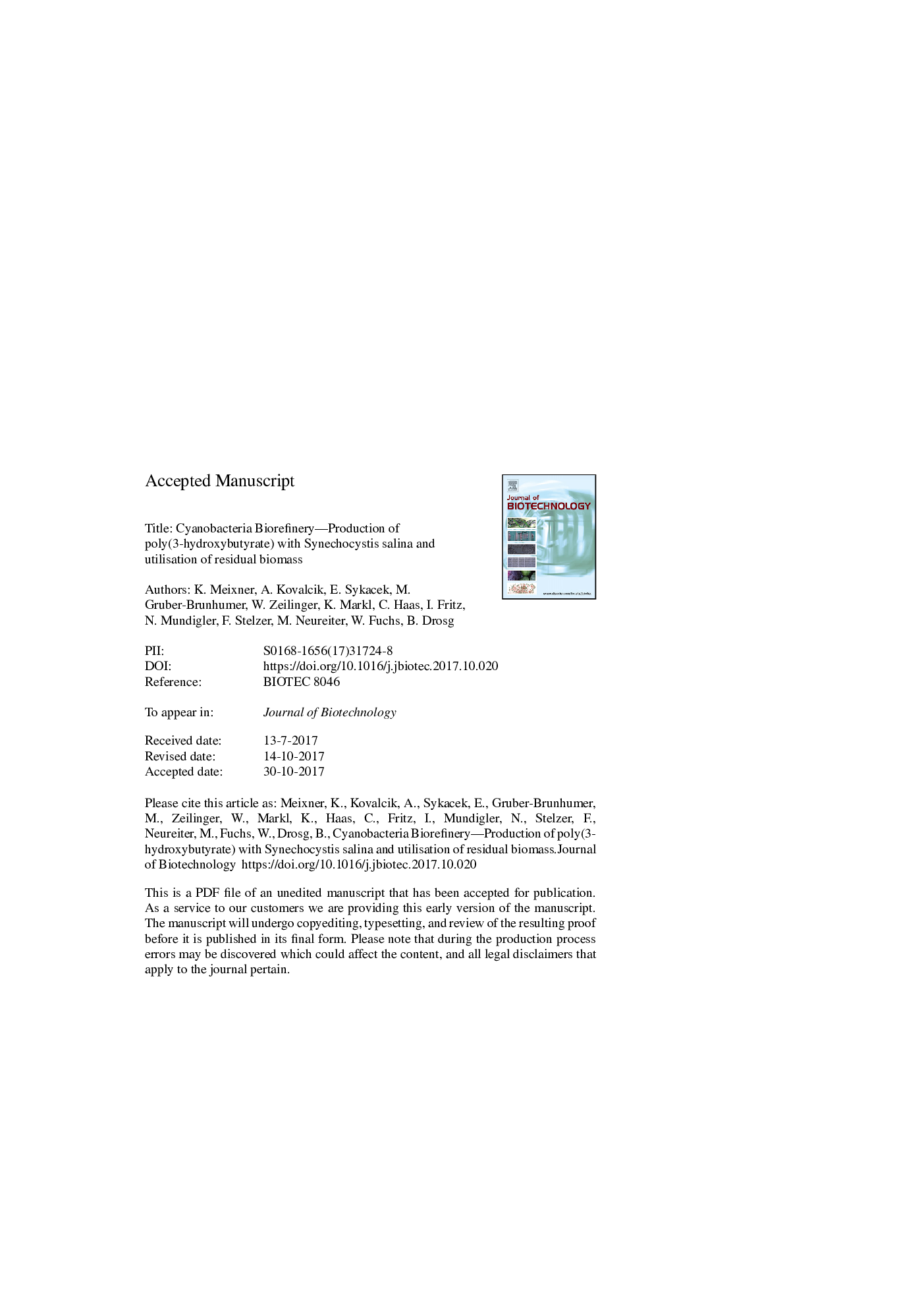| کد مقاله | کد نشریه | سال انتشار | مقاله انگلیسی | نسخه تمام متن |
|---|---|---|---|---|
| 6490439 | 1416978 | 2018 | 23 صفحه PDF | دانلود رایگان |
عنوان انگلیسی مقاله ISI
Cyanobacteria Biorefinery - Production of poly(3-hydroxybutyrate) with Synechocystis salina and utilisation of residual biomass
دانلود مقاله + سفارش ترجمه
دانلود مقاله ISI انگلیسی
رایگان برای ایرانیان
کلمات کلیدی
DSCΔHmAttenuated total reflection Fourier-transform infrared spectroscopytmaxGPCPHBVATR-FTIRPHAPHBTGACH4BiomethaneThermogravimetric analysis - تجزیه و تحلیل ترموگرافیglass transition temperature - دمای انتقال شیشهMelting Temperature - دمای ذوبMelting enthalpy - ذوب شدن آنتالپیResidual biomass - زیست توده باقی ماندهpolydispersity index - شاخص پلییدریزاییDownstream processing - فرایند فرآیند پایینBMP - مدیریت فرایند کسب و کارAnaerobic digestion - هضم بیهوازیMolecular weight - وزن مولکولیWeight average molecular weight - وزن مولکولی متوسط وزنNumber average molecular weight - وزن مولکولی میانگینbiochemical methane potential - پتانسیل متان بیوشیمیاییPoly(3-hydroxybutyrate) - پلی (3-hydroxybutyrate)Poly(3-hydroxybutyrate-co-3-hydroxyvalerate) - پلی (3-hydroxybutyrate-co-3-hydroxyvalerate)polyhydroxyalkanoate - پلی هیدروکسی آلکینواتPigments - پیگمنت یا رنگدانهDifferential scanning calorimetry - کالریمتری روبشی افتراقیGel permeation chromatography - کروماتوگرافی ژل تراوشیCrystallinity - کریستالی شدن یا تبلور
موضوعات مرتبط
مهندسی و علوم پایه
مهندسی شیمی
بیو مهندسی (مهندسی زیستی)
پیش نمایش صفحه اول مقاله

چکیده انگلیسی
This study evaluates a biorefinery concept for producing poly(3-hydroxybutyrate) (PHB) with the cyanobacterial strain Synechocystis salina. Due to this reason, pigment extraction and cell disruption were investigated as pre-treatment steps for the harvested cyanobacterial biomass. The results demonstrated that at least pigment removal was necessary to obtain PHB with processable quality (weight average molecular weight: 569-988 kg molâ1, melting temperature: 177-182 °C), which was comparable to heterotrophically produced PHB. The removed pigments could be utilised as additional by-products (chlorophylls 0.27-1.98 mg gâ1 TS, carotenoids 0.21-1.51 mg gâ1 TS, phycocyanin 0-127 mg gâ1 TS), whose concentration depended on the used nutrient source. Since the residual biomass still contained proteins (242 mg gâ1 TS), carbohydrates (6.1 mg gâ1 TS) and lipids (14 mg gâ1 TS), it could be used as animal feed or converted to biomethane (348 mn3 tâ1 VS) and fertiliser. The obtained results indicate that the combination of photoautotrophic PHB production with pigment extraction and utilisation of residual biomass offer the highest potential, since it contributes to decrease the environmental footprint of the process and because biomass could be used in a cascading way and the nutrient cycle could be closed.
ناشر
Database: Elsevier - ScienceDirect (ساینس دایرکت)
Journal: Journal of Biotechnology - Volume 265, 10 January 2018, Pages 46-53
Journal: Journal of Biotechnology - Volume 265, 10 January 2018, Pages 46-53
نویسندگان
K. Meixner, A. Kovalcik, E. Sykacek, M. Gruber-Brunhumer, W. Zeilinger, K. Markl, C. Haas, I. Fritz, N. Mundigler, F. Stelzer, M. Neureiter, W. Fuchs, B. Drosg,